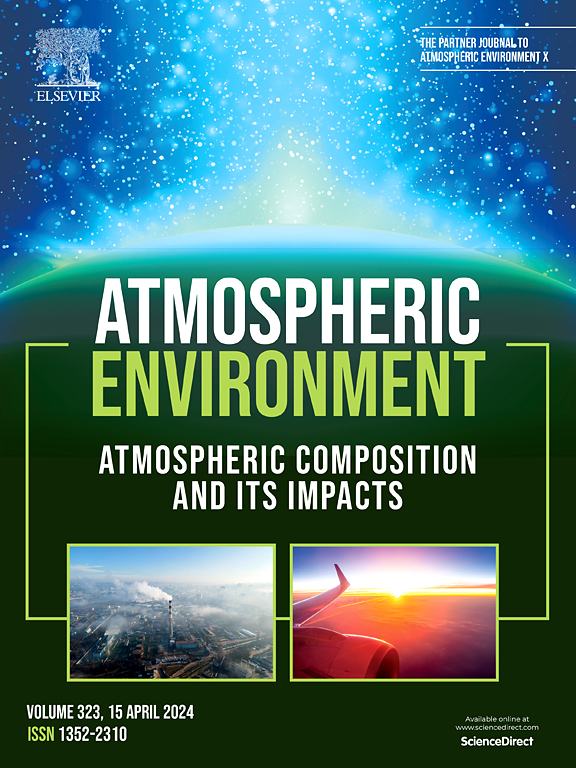Deciphering aerosol carbon fractions in PM2.5 & PM10 and their possible sources in Eastern Himalaya region
IF 4.2
2区 环境科学与生态学
Q2 ENVIRONMENTAL SCIENCES
引用次数: 0
Abstract
This study provides a comprehensive assessment of particulate matter (PM10 and PM2.5) and their carbonaceous fractions-organic carbon (OC) and elemental carbon (EC), across the Sikkim Himalaya region during the summer and winter of 2022. Sampling was conducted at four strategically selected locations: Gangtok (1151m), Pelling (1962m), Mangan (1353m), and Lachen (2740m). Due to harsh winter condition, Lachen was inaccessible, limiting winter sampling to the remaining three sites. Quartz filter-based low volume air sampling was employed to ensure high precision data collection. Annual average concentrations of PM2.5 exceeded the National Ambient Air Quality Standards (NAAQs) of 40 μg/m3, with the values of 66.48 ± 10.81 μg/m3 (Gangtok), 42.05 ± 17.48 μg/m3 (Pelling), and 61.39 ± 13.24 μg/m3 (Mangan). PM10 levels followed a similar trend: 89.99 ± 12.04 μg/m3 (Gangtok), 58.64 ± 20.17 μg/m3 (Pelling), 82.71 ± 14.94 μg/m3 (Mangan). Winter exhibited significantly higher OC and EC concentrations, especially in Gangtok, attributed to intensified vehicular emissions and biomass burning. The OC/EC ratio exceeding 2 in winter suggests enhanced secondary organic carbon formation, predominately from biomass and coal combustion. Gangtok exhibits the highest SOC/OC ratio, indicating enhanced secondary organic aerosol formation, likely due to higher anthropogenic emissions or favourable atmospheric conditions. In contrast, lower SOC/OC ratios in Pelling and Mangan suggest weaker atmospheric processing or lower VOC emissions. Correlation analysis indicates primary emissions as the dominant source of OC and EC, with transboundary pollution playing a critical role. Air mass Trajectory analysis highlights substantial pollution transport from Afghanistan, and the Indo-Gangetic plain, emphasizing the regional impact on Himalayan air quality. This study underscores, the urgent need for integrated air quality management strategies to mitigate both local and cross-border pollution, safeguarding the fragile Himalayan ecosystem and public health. A combination of emission control policies, real-time monitoring, and predictive modelling is essential to address the escalating air pollution crisis in this ecologically sensitive region.

东喜马拉雅地区PM2.5和PM10气溶胶碳组分及其可能来源解析
本研究对2022年夏季和冬季锡金喜马拉雅地区的颗粒物(PM10和PM2.5)及其碳质组分——有机碳(OC)和元素碳(EC)进行了全面评估。在四个战略选择的地点进行了抽样:Gangtok (115m), Pelling (1962m), Mangan (1353m)和Lachen (2740m)。由于冬季条件恶劣,拉琛无法进入,因此冬季采样仅限于其余三个地点。采用基于石英过滤器的小体积空气采样,保证了数据采集的高精度。PM2.5年均浓度超过国家环境空气质量标准(NAAQs) 40 μg/m3,分别为66.48±10.81 μg/m3(甘托克)、42.05±17.48 μg/m3(佩林)和61.39±13.24 μg/m3(曼甘)。PM10水平变化趋势相似:甘托克89.99±12.04 μg/m3,佩林58.64±20.17 μg/m3,曼甘82.71±14.94 μg/m3。由于车辆排放和生物质燃烧加剧,冬季OC和EC浓度显著升高,特别是在Gangtok。冬季OC/EC比值超过2表明次生有机碳的形成增强,主要来自生物质和煤的燃烧。Gangtok显示出最高的SOC/OC比率,表明二次有机气溶胶形成增强,可能是由于较高的人为排放或有利的大气条件。相比之下,Pelling和Mangan较低的SOC/OC比率表明较弱的大气处理或较低的VOC排放。相关分析表明,一次排放是OC和EC的主要来源,跨界污染起着关键作用。气团轨迹分析强调了来自阿富汗和印度恒河平原的大量污染运输,强调了对喜马拉雅空气质量的区域影响。这项研究强调,迫切需要综合空气质量管理战略,以减轻本地和跨境污染,保护脆弱的喜马拉雅生态系统和公众健康。排放控制政策、实时监测和预测模型的结合对于解决这个生态敏感地区不断升级的空气污染危机至关重要。
本文章由计算机程序翻译,如有差异,请以英文原文为准。
求助全文
约1分钟内获得全文
求助全文
来源期刊

Atmospheric Environment
环境科学-环境科学
CiteScore
9.40
自引率
8.00%
发文量
458
审稿时长
53 days
期刊介绍:
Atmospheric Environment has an open access mirror journal Atmospheric Environment: X, sharing the same aims and scope, editorial team, submission system and rigorous peer review.
Atmospheric Environment is the international journal for scientists in different disciplines related to atmospheric composition and its impacts. The journal publishes scientific articles with atmospheric relevance of emissions and depositions of gaseous and particulate compounds, chemical processes and physical effects in the atmosphere, as well as impacts of the changing atmospheric composition on human health, air quality, climate change, and ecosystems.
 求助内容:
求助内容: 应助结果提醒方式:
应助结果提醒方式:


